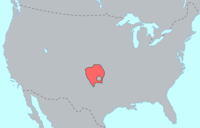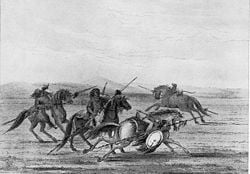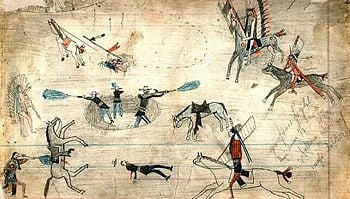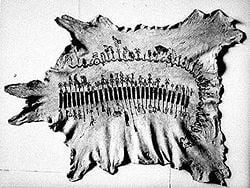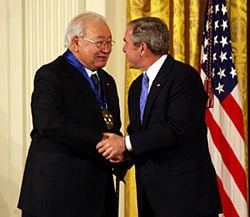Difference between revisions of "Kiowa" - New World Encyclopedia
| Line 51: | Line 51: | ||
===Calendars=== | ===Calendars=== | ||
[[Image:Calendari kiowa.jpg|left|thumb|250 px|Calender of 37 months, 1889-92, kept on a skin by Anko, a Kiowa man, ca. 1895.]] | [[Image:Calendari kiowa.jpg|left|thumb|250 px|Calender of 37 months, 1889-92, kept on a skin by Anko, a Kiowa man, ca. 1895.]] | ||
| − | Pictorial art was used by the Kiowa as well as other Plains Indians to maintain formal [[calendar]] records as well as to illustrate stories. | + | Pictorial art was used by the Kiowa as well as other Plains Indians to maintain formal [[calendar]] records as well as to illustrate stories. Kiowa calendar keepers kept the history of the tribe in written form by inscribing pictographic records of significant events on animal hides. The Kiowa had a complex calendar system with events recorded for both summer and winter of each year. The [[Kiowa#Sun Dance|Sun Dance]] ceremony provided the reference point for the summer on these calenders. |
| − | A particularly complex calendar produced by [[Silver Horn]] (or Haungooah) in 1904, was more richly illustrated. Silver Horn was one of the artists employed by [[James Mooney]], an [[anthropology|anthropologist]] with the [[Smithsonian]]'s Bureau of American Ethnology who worked on the Kiowa Reservation for many years. Silver Horn's calendar begins with the year 1828 and ends in 1904, with summer and winter pictures for most years. Summers are indicated by a green, forked pole, representing the center pole of the | + | A particularly complex calendar produced by [[Silver Horn]] (or Haungooah) in 1904, was more richly illustrated. Silver Horn was one of the artists employed by [[James Mooney]], an [[anthropology|anthropologist]] with the [[Smithsonian]]'s Bureau of American Ethnology who worked on the Kiowa Reservation for many years. Silver Horn's calendar begins with the year 1828 and ends in 1904, with summer and winter pictures for most years. Summers are indicated by a green, forked pole, representing the center pole of the Sun Dance, and winters by a bare tree. The calendar contains many interpretive notes made by Mooney, as he employed the artists to produce illustrations for field notes, not works of art for display. Nevertheless, many have been retained and are considered fine works of art in their own right. |
===Music=== | ===Music=== | ||
| − | [[Kiowa music]] is often noted for its [[hymn]]s that were traditionally accompanied by dance or played on the flute. | + | |
| + | The [[Kiowa]] are a [[Native Americans in the United States|Native American]] tribe. Their traditional [[music]] is strongly focused on [[dance|dancing]], such as the [[Sun Dance]] (''k'aw-tow''), when the people gather to build a [[lodge]] out of [[cottonwood]] trees; [[courtship]] is a traditional part of k'aw-tow celebrations, and this facet is often reflected in the music. A dance called the [[Brush Dance]] commemorates these gatherings. Both of the Dances were very important to the Kiowas. | ||
| + | |||
| + | Kiowa music, one of the most heavily recorded Native American musics, is part of the larger Southern Plains Indian music that is heavily influenced by the Omaha, often through the Ponca via the Omaha. The Kiowa adapted their flag song from the Arapaho, their memorial song and the dance bustle in the O-Ho-Mah Lodge warrior society from the Cheyenne. The Smithsonian Institute made recordings during the 1930s, '40s, and '50s that are close to 19th century music, while Indian House Records and Canyon Records began commercial recording in the '60s and '70s and Soundchief began recording in the '40s. (Carney and Foley 2003, p.287) | ||
| + | |||
| + | Much of Kiowa music is related to the [[warrior society|warrior societies]] of the 20th century. The Kiowas significant contributions to [[world music]] include the maintenance of traditions such as the [[Black Leggins Society]], the [[Oh-Ho-Mah Lodge]], the [[Kiowa Gourd Clan]], [[Peyote song]]s, and sacred Kiowa hymns. (ibid, p.286) | ||
| + | |||
| + | [[Cornel Pewewardy]] (flautist and full blood Comanche/Kiowa) is a leading performer of Kiowa/Southern Plains music, including Kiowa Christian [[hymn]]s which include prominent [[glissando]]s. (Broughton and Ellingham 2000, p.586) | ||
| + | |||
| + | |||
| + | Kiowa music is often noted for its [[hymn]]s that were traditionally accompanied by dance or played on the flute. Traditional performers include [http://www.hanksville.org/storytellers/pewe/ Cornel Pewewardy] and Phillip "Yogi" Bread. Modern Kiowa musicians such as Tom Mauchahty-Ware. | ||
| + | |||
| + | |||
| + | ===Sun Dance=== | ||
| + | |||
| + | The [[Sun Dance]] was the important religious ceremony for the Kiowa, as it was for many other plains Indian People. It was not a ceremony worshiping the [[sun]], but rather derived its name from the practice of gazing upward into the sun. It has also been called the Medicine Dance, because of the ceremonial significance of the event. The Sun Dance was usually held once a year during the summer, and provided a time not only for ceremonial and religious celebration, but also for gathering of the tribe and sharing of news, as well as individual healing and self-renewal. | ||
| + | |||
| + | The Sun Dance was usually held around the time of the summer [[solstice]].The ''Tai-me'' Keeper or priest played a central role in the Sun Dance, from deciding—based on inspiration received in a [[dream]]—whether the ceremony would be held to leading the preparations. The ''Tai-me'' was a small decorated stone figure covered with ermine and feathers. The Kiowa received their first ''Tai-me'' figure from an [[Arapaho]] man who married into the Kiowa tribe. The Arapaho had originally obtained a ''Tai-me'' figure from the [[Crow Indians]] during their Sun Dance. Originally, the Kiowa Sun Dance celebration lasted for about ten days, with six days of preparation, followed by four dancing days. The celebration followed a strict pattern of rituals on each of the ten days. | ||
| + | |||
| + | On the dancing days, the dance began at sunrise and the dancer's family selected an artist to paint designs on the dancer's body. Following prayers and ceremonial smokes, the dance continued throughout the day. During the four dancing days, spectators and singers were allowed to leave at midnight, but the dancers were required to remain in the [[sweat lodge]] without food or water. The only relief the dancers could receive from the heat of the day were [[waterlily|waterlillies]] to cool their heads and traditional ceremonial food. The ''Tai-me'' keeper would also fan the dancers. At certain times dancers would fall unconscious and experience visions. Unlike Sun Dances of other tribes such as the [[Sioux]], the Kiowa never pierced their skin or shed blood in anyway during the ceremony. For them, this was [[taboo]] and would bring misfortune upon the Kiowa People. | ||
| + | |||
| + | While the Sun Dance ceremonies were eventually banned by the United States government at the end of the nineteenth century, and the dance itself is no longer performed today, it still impacts Kiowa life. For example, the ten Kiowa Tah-lee Medicine bundles, which played a central role in the Sun Dance purification rituals are still cared for by tribal members charged with their safe protection. Purification through the use of the sweat lodge continues to this day. Other cultural activities such as the Warrior Society dances and the varied songs and music of the Kiowa have also been maintained. | ||
| + | |||
| + | The "peyote religion" or [[Native American Church]], founded by [[Comanche]] [[Quanah Parker]], includes aspects of the traditional Kiowa religion such as daybreak to daylight rituals and dancing. | ||
| + | |||
==Contemporary life== | ==Contemporary life== | ||
| Line 78: | Line 102: | ||
*Waldman, Carl. 2006. ''Encyclopedia of Native American Tribes.'' New York, NY: Checkmark Books. ISBN 978-0816062744 | *Waldman, Carl. 2006. ''Encyclopedia of Native American Tribes.'' New York, NY: Checkmark Books. ISBN 978-0816062744 | ||
*Wong, Hertha Dawn. 1992. ''Sending My Heart Back Across the Years: Tradition and Innovation in Native American Autobiography.'' Oxford University Press. ISBN 978-0195069129 | *Wong, Hertha Dawn. 1992. ''Sending My Heart Back Across the Years: Tradition and Innovation in Native American Autobiography.'' Oxford University Press. ISBN 978-0195069129 | ||
| + | |||
| + | *Broughton, Simon and Ellingham, Mark (2000). ''Rough Guide to World Music Volume Two: Latin and North America, theCaribbean, Asia & the Pacific''. ISBN 1-85828-636-0. | ||
| + | *Carney, George and Foley, Hugh Jr. (2003). ''Oklahoma Music Guide: Biographies, Big Hits, and Annual Events''. ISBN 1-58107-104-3. | ||
==External links== | ==External links== | ||
| Line 95: | Line 122: | ||
*[http://rebelcherokee.labdiva.com/itkiowa.html Kiowa Nation] | *[http://rebelcherokee.labdiva.com/itkiowa.html Kiowa Nation] | ||
*[http://rebelcherokee.labdiva.com/Kiowasundance.html SKAW-TOW The Last Kiowa Sun Dance] | *[http://rebelcherokee.labdiva.com/Kiowasundance.html SKAW-TOW The Last Kiowa Sun Dance] | ||
| + | *[http://www.uapress.arizona.edu/extras/kiowa/kiowasng.htm The Power of Kiowa Song: A Collaborative Ethnography] | ||
| − | {{Credits|Kiowa|167092095|}} | + | {{Credits|Kiowa|167092095|Kiowa_music|171445333}} |
Revision as of 17:21, 23 April 2008
| Kiowa |
|---|
| Guipago, a Kiowa Chief |
| Total population |
| 12,000[1] |
| Regions with significant populations |
| United States (Oklahoma) |
| Languages |
| English, Kiowa |
| Religions |
| Traditional |
| Related ethnic groups |
| other Tanoan peoples |
The Kiowa are a nation of Native Americans who lived mostly in north Texas, Oklahoma and eastern New Mexico at the time of the arrival of Europeans. Kiowa means "principal people" in their tribal language. Today the Kiowa Tribe is federally recognized, with about 12,000 members living in southwestern Oklahoma.
History
According to historic accounts the Kiowa resided in the northern basin of the Missouri River where the migrating Crow Nation first met them in the Pryor Mountains. The Kiowa then migrated easterly to the Black Hills around 1650. Pushed southward by the invading Cheyenne and Sioux, who were being pushed out of their lands in the great lakes regions by the Ojibwa tribes, the Kiowa moved down the Platte River basin to the Arkansas River area. There they fought with the Comanche, who already occupied the land.
In the early spring of 1790, at the place that would become Las Vegas, New Mexico, a Kiowa party lead by war leader Guikate made an offer of peace to a Comanche party while both were visiting the home of a friend of both tribes. This led to a later meeting between Guikate and the head chief of the Nokoni Comanches. The two groups made an alliance to share the same hunting grounds, and entered into a mutual defense pact. From that time on, the Comanches and Kiowa hunted, traveled, and made war together. An additional group, the Plains Apache (also called Kiowa-Apache), affiliated with the Kiowa at this time.
The Kiowa lived a typical Plains Indian lifestyle. Mostly nomadic, they survived on buffalo meat and gathered vegetables, lived in lodges, and depended on their horses for hunting and military uses. From their hunting grounds south of the Arkansas River the Kiowa were notorious for long-distance raids as far west as the Grand Canyon region, south into Mexico and Central America, and north into Canada.
In 1871 Kiowa leaders Satanta (White Bear), Satank (Sitting Bear) and Big Tree were accused, arrested, transported, and confined at Fort Richardson, Texas, after being convicted by a "cowboy jury" in Jacksboro, Texas for participating in the Warren Wagon Train Raid. During the transport to Fort Richardson, Texas, Satank was shot by accompanying cavalry troops in an escape attempt near Fort Sill, Indian Territory.
The Indian Wars
After 1840 the Kiowa, with their former enemies the Cheyenne, as well as their allies the Comanche and the Apache, fought and raided the Eastern natives then moving into the Indian Territory. The United States military intervened, and in the Treaty of Medicine Lodge of 1867 the Kiowa agreed to settle on a reservation in southwestern Oklahoma. However, some bands of Kiowa and others remained at large until 1875.
In 1874 war parties made up of young Cheyennes, Arapahos, Comanches, and Kiowas who refused to live on the reservations, frustrated and angered by the greatly diminished buffalo herd, attacked white hunters and settlers. Defeated by the cavalry in 1875, seventy-three of those considered most dangerous were rounded up and taken from Fort Sill, Oklahoma, to Fort Marion in Florida.
On August 6, 1901 Kiowa land in Oklahoma was opened for white settlement, effectively dissolving the contiguous reservation. While each Kiowa head of household was allotted 160 acres (320,000 m²), the only land remaining in Kiowa tribal ownership today is what was the scattered parcels of "grass land" that had been leased to the white settlers for grazing before the reservation was opened for settlement.
Famous Kiowa leaders were Dohasan (Tauhawsin, BIA), Over-Hanging Butte, alias Little Mountain, alias Little Bluff; Guipahgah (Old Chief Lonewolf), alias Guibayhawgu (Rescued From Wolves); sub-leaders Satanta and Satank.
Culture
Art
Kiowa artists are well known for a pictographic art form that is now referred to as "Plains Indian ledger art."
Ledger art derives from a historical tradition that used traditional pictographs to keep historical records and serve as mnemonic reminders for storytelling. A traditional male art form, Plains Indian warriors drew pictographic representations of heroic deeds and sacred visions, which served to designate their positions in the tribe. Traditionally the artist's medium for their pictographic images were rocks and animal skins, but for the Kiowa in captivity the lined pages of the white man's record keeping books (ledgers) became a popular substitute, hence the name "ledger art."
The earliest of these Kiowa artists were held in captivity by the US Army at Fort Marion in St. Augustine, Florida at the conclusion of the Southern Plains Indian war. Captain Richard Henry Pratt was sympathetic and very liberal for his time, wanting to educate his captives and make them self-sufficient. At Fort Marion he initiated an educational experiment as an alternative to standard imprisonment, culminating in his founding of the Carlisle Indian School in 1879. Throughout their incarceration, the Plains Indian leaders followed Pratt's rules and met his educational demands even as they remained true to their own identities, practicing traditional dances and ceremonies (Lookingbill 2006). In addition to regular studies Pratt encouraged them to pursue their native arts and to sell the products, keeping the profits for themselves. As a result, many of the Kiowa achieved self-sufficiency, as well as developing their art form into the now famous ledger art. For these former warriors their art was not just a way of making money but a form of resistance. The warrior-artists of Fort Marion preserved their history in their traditional pictographic representations, drawn on the the very records, the ledgers, that recorded the expansion of the Euro-American lifestyle. This can be seen as a significant transition between the old traditional identity and finding a place in the new culture. The warrior-artist drawing pictographic representations of his tribal history in a ledger book may "be seen as a personal treaty—an attempt to negotiate between one’s individual/tribal identity and a new dominant culture” (Wong 1992).
After the return of the Fort Marion warriors to the reservation there was a general withering of this artistic flowering. The most significant ledger book artist was a Kiowa named Haungooah (Silver Horn), whose brother, Ohettoit, was one of the captives in Fort Marion. Silver Horn worked with his brother decorating traditional tipis and then to produce ledger book art work. Silver Horn reputedly influenced both James Auchiah and Stephen Mopope in their work before they became a part of the Kiowa Five, whose artistic style is generally recognized as the beginning of the modern Native American Art Movement.
The Kiowa Five were a group of artists who studied at the University of Oklahoma. The "Five" referred to are the male members of the group, although there was a sixth member, a woman named Lois Smokey.
The influence of Kiowa art and the revival of ledger art is illustrated in the early work of Cherokee-Creek female artist Virginia Stroud and Spokane artist George Flett. While Stroud is of Cherokee-Creek descent, she was raised by a Kiowa family and the traditions of that culture, and the influence of the Kiowa tradition is evident in her early pictographic images. Well known Kiowa artists of the later twentieth century include Bobby Hill (White Buffalo), Robert Redbird, Roland N. Whitehorse, and T. C. Cannon. The pictographic art of contemporary and traditional artist Sherman Chaddlesone has revived the ledger art form that was absent in most of the art of the Second Generation Modernists that had developed since Silverhorn and the Kiowa Five.
Calendars
Pictorial art was used by the Kiowa as well as other Plains Indians to maintain formal calendar records as well as to illustrate stories. Kiowa calendar keepers kept the history of the tribe in written form by inscribing pictographic records of significant events on animal hides. The Kiowa had a complex calendar system with events recorded for both summer and winter of each year. The Sun Dance ceremony provided the reference point for the summer on these calenders.
A particularly complex calendar produced by Silver Horn (or Haungooah) in 1904, was more richly illustrated. Silver Horn was one of the artists employed by James Mooney, an anthropologist with the Smithsonian's Bureau of American Ethnology who worked on the Kiowa Reservation for many years. Silver Horn's calendar begins with the year 1828 and ends in 1904, with summer and winter pictures for most years. Summers are indicated by a green, forked pole, representing the center pole of the Sun Dance, and winters by a bare tree. The calendar contains many interpretive notes made by Mooney, as he employed the artists to produce illustrations for field notes, not works of art for display. Nevertheless, many have been retained and are considered fine works of art in their own right.
Music
The Kiowa are a Native American tribe. Their traditional music is strongly focused on dancing, such as the Sun Dance (k'aw-tow), when the people gather to build a lodge out of cottonwood trees; courtship is a traditional part of k'aw-tow celebrations, and this facet is often reflected in the music. A dance called the Brush Dance commemorates these gatherings. Both of the Dances were very important to the Kiowas.
Kiowa music, one of the most heavily recorded Native American musics, is part of the larger Southern Plains Indian music that is heavily influenced by the Omaha, often through the Ponca via the Omaha. The Kiowa adapted their flag song from the Arapaho, their memorial song and the dance bustle in the O-Ho-Mah Lodge warrior society from the Cheyenne. The Smithsonian Institute made recordings during the 1930s, '40s, and '50s that are close to 19th century music, while Indian House Records and Canyon Records began commercial recording in the '60s and '70s and Soundchief began recording in the '40s. (Carney and Foley 2003, p.287)
Much of Kiowa music is related to the warrior societies of the 20th century. The Kiowas significant contributions to world music include the maintenance of traditions such as the Black Leggins Society, the Oh-Ho-Mah Lodge, the Kiowa Gourd Clan, Peyote songs, and sacred Kiowa hymns. (ibid, p.286)
Cornel Pewewardy (flautist and full blood Comanche/Kiowa) is a leading performer of Kiowa/Southern Plains music, including Kiowa Christian hymns which include prominent glissandos. (Broughton and Ellingham 2000, p.586)
Kiowa music is often noted for its hymns that were traditionally accompanied by dance or played on the flute. Traditional performers include Cornel Pewewardy and Phillip "Yogi" Bread. Modern Kiowa musicians such as Tom Mauchahty-Ware.
Sun Dance
The Sun Dance was the important religious ceremony for the Kiowa, as it was for many other plains Indian People. It was not a ceremony worshiping the sun, but rather derived its name from the practice of gazing upward into the sun. It has also been called the Medicine Dance, because of the ceremonial significance of the event. The Sun Dance was usually held once a year during the summer, and provided a time not only for ceremonial and religious celebration, but also for gathering of the tribe and sharing of news, as well as individual healing and self-renewal.
The Sun Dance was usually held around the time of the summer solstice.The Tai-me Keeper or priest played a central role in the Sun Dance, from deciding—based on inspiration received in a dream—whether the ceremony would be held to leading the preparations. The Tai-me was a small decorated stone figure covered with ermine and feathers. The Kiowa received their first Tai-me figure from an Arapaho man who married into the Kiowa tribe. The Arapaho had originally obtained a Tai-me figure from the Crow Indians during their Sun Dance. Originally, the Kiowa Sun Dance celebration lasted for about ten days, with six days of preparation, followed by four dancing days. The celebration followed a strict pattern of rituals on each of the ten days.
On the dancing days, the dance began at sunrise and the dancer's family selected an artist to paint designs on the dancer's body. Following prayers and ceremonial smokes, the dance continued throughout the day. During the four dancing days, spectators and singers were allowed to leave at midnight, but the dancers were required to remain in the sweat lodge without food or water. The only relief the dancers could receive from the heat of the day were waterlillies to cool their heads and traditional ceremonial food. The Tai-me keeper would also fan the dancers. At certain times dancers would fall unconscious and experience visions. Unlike Sun Dances of other tribes such as the Sioux, the Kiowa never pierced their skin or shed blood in anyway during the ceremony. For them, this was taboo and would bring misfortune upon the Kiowa People.
While the Sun Dance ceremonies were eventually banned by the United States government at the end of the nineteenth century, and the dance itself is no longer performed today, it still impacts Kiowa life. For example, the ten Kiowa Tah-lee Medicine bundles, which played a central role in the Sun Dance purification rituals are still cared for by tribal members charged with their safe protection. Purification through the use of the sweat lodge continues to this day. Other cultural activities such as the Warrior Society dances and the varied songs and music of the Kiowa have also been maintained.
The "peyote religion" or Native American Church, founded by Comanche Quanah Parker, includes aspects of the traditional Kiowa religion such as daybreak to daylight rituals and dancing.
Contemporary life
Kiowa author N. Scott Momaday won the 1969 Pulitzer Prize for his novel House Made of Dawn. Other Kiowa authors include playwright Hanay Geiogamah, poet and film maker Gus Palmer, Jr., Alyce Sadongei, and Tocakut.
ReferencesISBN links support NWE through referral fees
- Berlo, Jane Catherine. 1996. Plains Indian Drawings 1865-1935. Harry N. Abrams. ISBN 978-0810937420
- Boyd, Maurice. 1981. Kiowa Voices: Ceremonial Dance, Ritual, and Song, Vol. 1. Texas Christian University Press. ISBN 978-0912646671
- ———. 1983. Kiowa Voices: Myths, Legends and Folktales. Texas Christian University Press. ISBN 978-0912646763
- Corwin, Hugh. 1958. The Kiowa Indians, Their History and Life Stories.
- Greene, Candace S. 2002. Silver Horn: Master Illustrator of the Kiowas. University of Oklahoma Press. ISBN 978-0806133072
- Hoig, Stan. 2000. The Kiowas and the Legend of Kicking Bird. Boulder: The University Press of Colorado. ISBN 0870815644
- Lookingbill, Brad D. 2006. War Dance at Fort Marion: Plains Indian War Prisoners. Norman, OK: University of Oklahoma Press. ISBN 978-0806137391
- Mishkin, Bernard. 1988. Rank and Warfare Among The Plains Indians. AMS Press. ISBN 0404629032
- Momaday, N. Scott. 1977. The Way to Rainy Mountain. University of New Mexico Press. ISBN 0826304362
- Mooney, James. 2007. Calender History of the Kiowa Indians. Kessinger Publishing. ISBN 978-0548136461
- Nye, Colonel W.S. 1983. Carbine and Lance: The Story of Old Fort Sill. Norman, OK: University of Oklahoma Press. ISBN 0806118563
- Richardson, Jane. 1988. Law & Status Among the Kiowa Indians American Ethnological Society Monographs; No 1. AMS Press. ISBN 0404629016
- Waldman, Carl. 2006. Encyclopedia of Native American Tribes. New York, NY: Checkmark Books. ISBN 978-0816062744
- Wong, Hertha Dawn. 1992. Sending My Heart Back Across the Years: Tradition and Innovation in Native American Autobiography. Oxford University Press. ISBN 978-0195069129
- Broughton, Simon and Ellingham, Mark (2000). Rough Guide to World Music Volume Two: Latin and North America, theCaribbean, Asia & the Pacific. ISBN 1-85828-636-0.
- Carney, George and Foley, Hugh Jr. (2003). Oklahoma Music Guide: Biographies, Big Hits, and Annual Events. ISBN 1-58107-104-3.
External links
- Kiowa Collection: Selections from the Papers of Hugh Lenox Scott
- Kiowa Comanche Apache Indian Territory Project
- Kiowa ledger drawing in the Smithsonian.
- Photographs of Kiowa Indians hosted by the Portal to Texas History
- The Handbook of Texas Online: Kiowa Indians
- The Kiowa Five.
- Sketch of a Chief of the Kiowas from A pictorial history of Texas, from the earliest visits of European adventurers, to AD 1879, hosted by the Portal to Texas History.
- The Kiowa Five, Kiowa Indian Art Collection Western History Collections University of Oklahoma Libraries.
- Silver Horn Pictorial Calendar
- Ledger Art
- Virginia Stroud Artist Profile
- About The Kiowa Five
- Kiowa Nation
- SKAW-TOW The Last Kiowa Sun Dance
- The Power of Kiowa Song: A Collaborative Ethnography
Credits
New World Encyclopedia writers and editors rewrote and completed the Wikipedia article in accordance with New World Encyclopedia standards. This article abides by terms of the Creative Commons CC-by-sa 3.0 License (CC-by-sa), which may be used and disseminated with proper attribution. Credit is due under the terms of this license that can reference both the New World Encyclopedia contributors and the selfless volunteer contributors of the Wikimedia Foundation. To cite this article click here for a list of acceptable citing formats.The history of earlier contributions by wikipedians is accessible to researchers here:
The history of this article since it was imported to New World Encyclopedia:
Note: Some restrictions may apply to use of individual images which are separately licensed.
